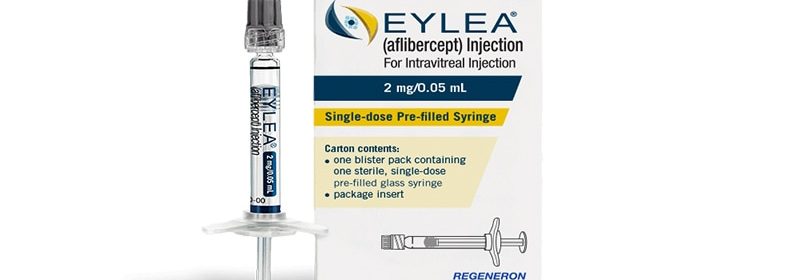Higher Aflibercept Dose Safe as 2 mg

SEATTLE, WA — An 8-mg dose formulation of aflibercept (Eylea, Regeneron) has shown promise in treating macular disease, according to clinical trial findings presented at the 41st Annual Meeting of the American Society of Retina Specialists.
Compared with a 2‑mg formulation, the 8-mg formulation provided a fourfold higher molar dose, lengthening the duration of action and allowing the drug to be given at 12- or 16‑week intervals instead of the 8-week intervals used with the lower formulation for the treatment of neovascular age-related macular degeneration (nAMD).
Interim results from the trial’s halfway point of 48 weeks were presented during the meeting’s first Wet AMD Symposium by Jignesh Patel, MD, a study investigator and an attending retina specialist at Colchester Hospitals University Foundation Trust, United Kingdom.
The high-dose formulation met its primary efficacy endpoint of change in best-corrected visual acuity (BCVA) from baseline to the halfway point, by a noninferiority margin of four letters (P < .01 for both high-dose regimens vs the low-dose regimen).
More than 1000 patients over the age of 50 participated in the phase 3, noninferiority trial. The PULSAR investigators found that by week 16, 63% of those receiving the high-dose formulation had no fluid in the central subfield compared with 52% of low-dose patients (P < .01).
More Discoveries
Investigators analyzed the percentage of patients receiving high doses who were able to maintain a longer treatment interval. They found that more than three-quarters of participants were still receiving doses every 12 weeks by 48 weeks.
Patients in the trial could also receive the higher dose at shorter intervals of as little as 8 weeks if they lost at least five letters of BCVA and had an increase in central subfield thickness of at least 25 μm. A post hoc analysis found no difference in baseline characteristics such as BCVA or lesion size between those who needed a shorter treatment interval and those who did not.
Additional Populations
Similar results were found in those with or without polypoidal choroidal vasculopathy (PCV; 141 and 153 patients, respectively, plus three dropouts). A greater percentage of patients with PCV who received 8-mg aflibercept had an absence of fluid in the center subfield compared with the 2-mg group (66% vs 63%).
In addition, “86% of patients with PCV treated with eight milligrams were maintained on 12‑week intervals, showing potential durability,” said David Wong, MD, an investigator in the subgroup analysis and an associate professor at the University of Toronto St. Michael’s Hospital, Canada, who presented the analysis results. “The safety profile of the 8-mg dose was similar in the PCV subgroup to that in the overall population, which was then similar to that in the 2-mg aflibercept group.”
The findings call into question the exclusion of PCV patients from many nAMD studies, he said.
“I think one of the things we need to look at is polyp closure,” Wong said. “But if you look at previous studies, this drug [aflibercept] does close polyps. Those cases with polyps can be the problem. We need to look and make sure those polyps are fully closed.”
Effective Regardless of Baseline Characteristics
Another post hoc analysis of treatment-naïve patients found similar improvement in BCVA letter scores between those who had a baseline central subfield retinal thickness of less than 400 μm or of 400 μm or more.
Results were also similar whether patients had the minimally classic, occult, or predominantly classic type of choroidal neovascular lesion.
“This is another piece of evidence telling us that lesion classification may not be relevant,” said Keyvan Koushan, MD, a vitreoretinal surgeon at the Toronto Retina Institute, Ontario, Canada, who participated in the post hoc analysis and presented its results at the meeting.
Absolute BCVA values at week 48 were comparable regardless of differences in baseline BCVA. However, the 70% of patients in the study who identified as Asian were slightly more likely to maintain longer treatment intervals than the 30% of patients in the study who were Caucasian (81.8% vs 78.3% for q12 and 87.3% vs 73.8% for q16, respectively).
Perhaps most important, PULSAR showed similar safety profiles for both dose formulations. More than 1000 participants received the 8-mg dose, and none experienced endophthalmitis, occlusive retinal vasculitis, or ischemic optic neuritis.
“The incidence of intraocular inflammation was low and similar between the 8-mg and the 2-mg dose,” said Philip Ferrone, MD, a partner at Vitreoretinal Consultants of New York in Great Neck. “And there were no clinically significant increases in interocular pressure reported with the 8-mg dose.”
In addition, the incidence of nonocular treatment-emergent adverse events — like Antiplatelet Trialists Collaboration events — was similar for the two doses.
American Society of Retina Specialists (ASRS) 2023 Annual Meeting. Presented July 29, 2023.
The study was funded by Bayer AG and Regeneron Pharmaceuticals. Jignesh, Chow, Wong, and Koushan are consultants to Bayer. Koushan is also a principal investigator for Bayer. Ferrone is a principal investigator for Regeneron.
A former staff reporter for Cardio magazine and contributor to MD Magazine’s vision disease coverage, Ellen Kurek earned her nonfiction writing certificate from the University of Washington.
Source: Read Full Article